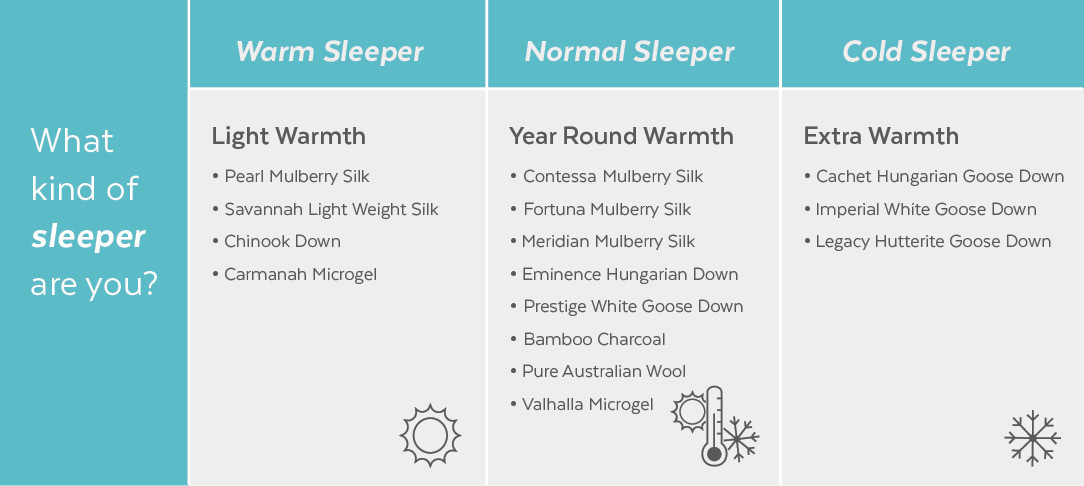5 Factors to Consider When Picking a Duvet
2020 Sep 17th
Too hot, too cold. Too heavy, too light. Too flat, too fluffy…
Picking the perfect duvet can be a bit like a Goldilocks story! But when you find a duvet that’s “just right”, it can do wonders for the quality of your sleep. So it’s worth taking the time to figure out which duvet is right for you.
Not sure where to start? Before getting into the different factors to consider when picking a duvet, it’s important to ask yourself one question…
What Kind of Sleeper Are You?
Typically, there are three different types of sleepers:
Warm sleeper: You get hot easily in your current bedding. (This is a common issue for women during menopause!) You’re the sleeper that kicks off the covers and constantly adjusts your limbs to try and find new cold spots. You probably keep your home on the cool side.
Normal sleeper: You’re low maintenance when it comes to sleeping and can easily doze off on the couch or in the car. You only feel too hot or too cold during your sleep on extreme weather days. You rarely feel the need to adjust the thermostat at home.
Cold sleeper: Double, no, triple up on blankets! You struggle to sleep because all you can think about are the tiny pockets of cold air that surround your body where there’s a draft between the sheets. You likely keep your home on the warm side.
Any of these descriptions sound familiar?
If not, you may fall between two categories — somewhere along the spectrum of warm and cold. If that’s the case, consider stocking up on different duvets to use in different seasons. That is, a heavier duvet for cool months and a lighter duvet for warm months.
But as a general rule of thumb, these are the ideal pairings:
Warm Sleeper = Light Warmth Duvet
Normal Sleeper = Year Round Warmth Duvet
Cold Sleeper = Extra Warmth Duvet
Here’s a chart to help you easily determine which QE Home duvet is right for you:

Now that you have a good starting point, here are some factors to help narrow down your choice!
5 Factors to Consider When Picking a Duvet
![]()
1. FILLING – Why get down with down:
Duvets are typically made with one of two types of filling: natural (down, silk, bamboo, wool) or synthetic (microgel).
Down is the layer of fine feathers embedded near the roots of larger, more rigid feathers on a bird. Down comes in different colours and can vary in quality depending on factors such as the maturity and species of the bird. Duvets are usually filled with either duck down or goose down. In general, duck down is cooler and more lightweight, while goose down, being larger in size, is warmer and more insulating.
Silk and bamboo filled duvets are 100% hypoallergenic, which makes them ideal for people with sensitive skin and allergies. These natural fibers are excellent insulators and excel at wicking away moisture to keep sleepers cool and dry. This also makes them a good choice for warmer sleepers.
Wool fill can wick up to a third of its weight in moisture! This helps maintain a fresh, dry sleep environment. Wool is also considered a sustainable textile, as it comes from an animal-friendly, renewable resource. Slightly weightier and more dense, wool makes for a good year round or winter duvet.
Finally, there’s also synthetic fills that emulate down, like microgel. Microgel is made of 100% polyester, so it’s hypoallergenic and easy to care for. For those seeking an affordable option with great value, a microgel duvet may be just the thing. But it’s worth noting, to equal the warmth of a down duvet, a microgel duvet requires roughly three times the amount of filling. So synthetic duvets can be a bit heavier on the body.
![]()
2. WARMTH/WEIGHT – Match your sleeper profile:
Fill type is just one part of the equation. Fill power is the second part! Together, fill type and fill power determine the weight and warmth of your duvet. So what is fill power? Simply put, it refers to the volume of filling in your duvet.
For non-down, fill power equals how much filling is used and determines the weight of a duvet. So the more fill, the warmer the duvet!
Things get a little trickier with down...
Fill power for down refers to the volume or “loft” the down creates. So with a higher quality down, you can achieve a higher fill power with less filling. It all depends on how much space the down fills up, rather than how much down there is, ounce per ounce.
For example, one ounce of luxury goose down can fill up more space than one ounce of a lower quality duck down, so it can trap more air within the duvet and create more warmth… without needing more fill! That’s why, 32 ounces of white goose down with a fill power of 650 will be warmer than 38 ounces of duck down with a fill power of only 500.
Quick tip: When buying for family, know that youngsters tend to sleep warmer, so they need a lighter warmth duvet!
![]()
3. TICKING/SHELL – Count those threads:
The ticking is the outer shell or casing of a duvet. Typically, you’ll judge a duvet’s ticking by how high the thread count is. Anything above a 220 thread count is classified as “down proof” (no down can escape). So a higher thread count doesn’t make a fabric more down proof!
That said, the higher the thread count, the softer and lighter the outer fabric will be. This allows for greater loft from the down filling and a smoother hand-feel.
The ticking can also be made out of alternative fibers, like bamboo. A bamboo shell provides excellent temperature regulating properties, making it a good choice for warm sleepers.
![]()
4. CONSTRUCTION – Baffle is best:
There are several different methods of construction for duvets. But one of the best methods is called the “baffle box”! Essentially, this involves stitching a grid of boxes within a duvet. These boxes allow space for the down to loft and remain evenly distributed, leaving no cold spots.
Another common method is the “stitched box”. With this method, a grid is stitched directly through both layers of ticking. The disadvantage of this approach is that cold spots can occur along the sew lines where down is scarce and compressed. But your duvet will have a more sculpted look, and if you run hot, you may actually appreciate having some cool spots.
![]()
5. LAYERING UP – Figure out your fabrics:
Don’t forget to take into consideration the other layers of fabric you choose to include on your bed! If you’re someone who likes to sleep with a coverlet, flat sheet, or even a thicker, jacquard duvet cover, these layers of fabric will all increase the warmth and weight of your bedding.
For example, if you’re a warm sleeper, choosing a year round warmth duvet and adding a jacquard duvet cover could be too hot for you. If you love the jacquard look, you may want to opt for a light warmth duvet. On the other hand, if you’re a cold sleeper, the combination of a year round warmth duvet and jacquard duvet cover could be ideal!
Quick tip: To increase the longevity and effectiveness of your down duvet, avoid weighing it down with heavy layers or by constantly sitting on top of it. This compresses the down, reducing its ability to loft over time.
Now, You're a Duvet Expert!
Overall, choosing the perfect duvet is about your comfort and your needs. Start by figuring out what warmth is best for you, then narrow down your choice by taking into consideration factors like filling, ticking, and construction.
In the end, a good duvet is a worthwhile investment that can last up to 20 years… that’s 20 years of better sleep (and a better quality of life)!
But if all this information seems overwhelming, not to worry. We’re here to help! Stop by one of our 70+ locations to chat or book a free, virtual consultation with one of our friendly bedding experts. They can help you choose the best duvet for your specific needs!☺
